Equipment Reports: Vector Research VRX-9000
receiver; Dynavector 20A Type 2 cartridge; Dynaco A-250 speaker; Onkyo TA-2080
cassette deck; Koss HV/X headphones; ADC Sound Shaper Three equalizer
Preparation supervised by Robert Long, Peter Dobbin, and Edward J. Foster. Laboratory data (unless otherwise noted) supplied by CBS Technology Center or Diversified Science Laboratories.
-----------------------
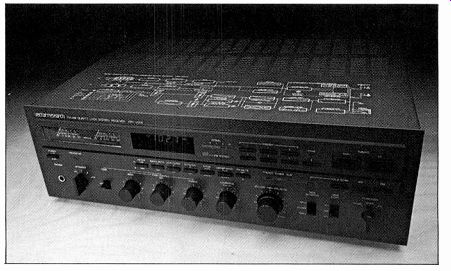
Vector Aims at U.S.
Vector Research Model VRX-9000
Tuner Section
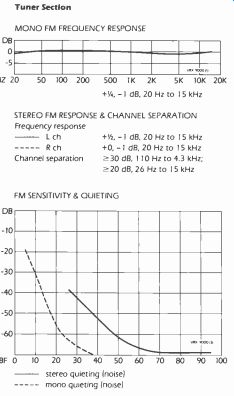
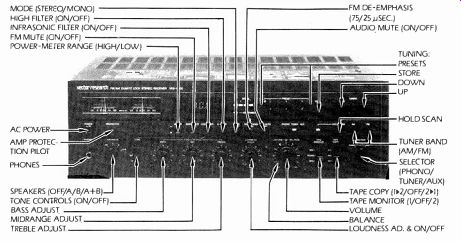

Vector Research Model VRX-9000 AM/FM receiver in metal case. Dimensions: 17 1/4 by 5 3/8 inches (front), 13 3/8 inches deep plus clearance for connections. Convenience outlets: one switched (100 watts), one unswitched (200 watts). Price: $750; optional VKD-1 wood case, $25; optional VMA rack handles, $35; optional VRC-1 wired remote control, $75. Warranty: "limited," two years parts and labor. Manufacturer: made in Japan for Vector Research, Inc., 20600 Nordhoff St., Chatsworth, Calif. 91311.
Vector Research, a new American-based company with manufacturing facilities in Japan, is doing what some foreign-based companies find difficult: providing the U.S. market with sophisticated audio products that have carefully judged features at attractive price points. Its first offerings are three cassette decks and three receivers, of which the VRX-9000 is the flagship.
Though the purchase of separate audio electronics (tuner, preamp, and power amp) can still be justified by specific user needs, increased flexibility, and, sometimes, better performance, the VRX-9000 goes a long way toward blurring the distinctions between separates and receivers. One would have to spend a great deal more for separates with the features in this relatively compact receiver. The array of tiny buttons may give one pause, but a moment or two of examination reveals their neatly logical planning. Frequency-synthesized tuning is accomplished in discrete manual steps (0.1 MHz on FM, 1 kHz on AM) via the separate UP and DOWN buttons. To activate the automatic station scanning function, you simply depress HOLD SCAN and either UP or DOWN. With FM MUTE engaged, stations with a signal strength of at least 26 dBf in stereo or 19 dBf in mono (for quieting levels of 38 1/2 and 53 1/4 dB, respectively) lock in and hold for several seconds. This can be a bit tedious in areas where there are many weak stations, because the stereo threshold is not adjustable and the circuit holds stations that, to our ears, are more noise than music. But once you receive a clear broadcast, you can enter it for retrieval by depressing STORE and any one of the six numbered presets. An LED above STORE illuminates for a few seconds, indicating the memory's willingness to cooperate; if you do not press a preset within a few seconds, it quietly blinks out. The owner's manual says that the memory circuits will retain presets for up to twenty-four hours even with external power disconnected but advises that two AA cells be loaded into the compartment on the rear of the unit for memory retention of up to one year.
Data from Diversified Science Labs prove the tuner section capable of very good overall performance. Frequency readout is almost dead-on accurate, showing a deviation of just 0.01 MHz at each of our FM test frequencies. Sensitivity is quite high, which leads us to question the usefulness of the five-segment LED signal-strength indicator. Like most of these devices, it is of little help for antenna orientation or for finding extremely weak stations; the most sensitive of the LEDs responds to a minimum signal of 25 dBf, which is almost exactly the stereo muting threshold and well above the minimum for useful mono reception.
The preamp section tests out quite nicely, too. RIAA equalization is accurate, particularly so for a receiver. Outstanding, in our opinion, is the flexibility in loudness contouring, which has its own adjustment knob and thus can be matched to any speaker efficiency. The lab's graphs show that the LOUDNESS control lowers levels throughout and beyond the midrange, thereby raising the relative level of the deep bass and, to some extent, the extreme treble. As you turn the knob clockwise, the absolute level diminishes somewhat. This may seem confusing at first, since volume controls work in the opposite direction; once you realize that its purpose is to increase the degree of compensation, all becomes clear. We could not wish for a more effective and gentle compensation scheme.
The bass and treble controls are fairly standard in their operation. So is that for the midrange; its boost/cut action is less extreme than that for the other two, as it should be. The lab discovered, however, that the TONE DEFEAT is not absolute: Some interaction remains if the bass has been left at its maximum setting.
Tests of the power amp section indicate the kind of real-world design that is inherent in the VRX-9000. Clipping of continuous tones does not occur until output is 20 1/4 dBW (106 watts)-a full 1 1/4 dBW above its 80-watt rating, and an additional 1 1/4 dB of output in the pulse test, for the equivalent of 140 watts on musical peaks. Low-frequency damping factor is extremely generous, and total harmonic distortion figures come in far below the rated 0.08% across the audible band at both 0 dBW and rated output. As we've said many times before, power meters on amplifiers or receivers are more cosmetic than useful, and those on the VRX-9000 confirm our contention. Though reasonably accurate at both the low and high scales, the ballistics are quite slow in responding to pulses, thereby obviating their use as clipping-level indicators.
As an alternative to separates, a receiver with such sophisticated performance and functions demands attention. The phono section and amplifier impressed us with their effortless reproduction. And, though we would have preferred an adjustable muting threshold, or at least a fast-scan mode in the tuner, it performed flawlessly-never losing its quartz-lock grip on a selected station. This is one of those receivers that seem to ask for eye-level placement; with so many buttons arranged along a matte black background and marked in very small print, only an unobstructed, head-on view prevents confusion. But as we have stated in the past, there are some products for which we'd be willing to reorganize our system and its lighting rather than pass up a good component. The VRX-9000 is such a product.
======================
A Pickup for Those in Search of Perfection
Dynavector Model DV-20A Type 2 stereo phono pickup, with elliptical diamond stylus. Price: $230. Warranty: "limited," one year parts and labor, excluding stylus wear. Manufacturer: Acousta Ginza, Japan; U.S. distributor: Dynavector Systems U.S.A., Inc., 30708 Lakefront Dr., Agoura, Calif. 91301.
Dynavector is rapidly distinguishing itself in the cartridge market for its continuing exploration of moving-coil pickup technology. While even rabid ... ...perfectionists may balk at a $1,000 pickup equipped with a solid diamond cantilever, Dynavector has one available. The unit reviewed here, the DV-20A Type 2, is more affordable, but under its "tin can" hood lurk several noteworthy technical innovations. This is a high-output design; that is, the output voltage is sufficient to drive a preamp without a head amp stage or stepup transformer. The cartridge has the moving-coil's virtue of being essentially insensitive to reactive properties of the load it must operate into and thus should work equally well with a wide range of preamps, receivers, and integrated amps.
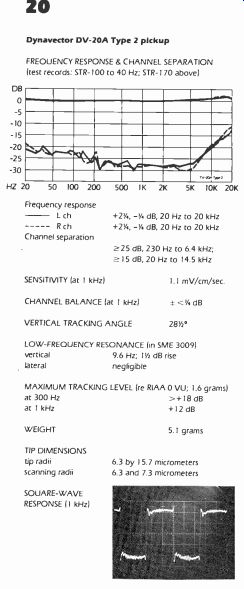
---- FREQUENCY RESPONSE & CHANNEL SEPARATION (test records: STR-I00
to 40 Hz; STR-170 above)
Frequency response L ch +21/4,-V. dB, 20 Hz to 20 kHz R ch +21/4,-1/4 dB, 20 Hz to 20 kHz Channel separation 25 dB, 230 Hz to 6.4 kHz; 15 dB, 20 Hz to 14.5 kHz
SENSITIVITY (at I kHz) 1.1 mV/cm/sec.
CHANNEL BALANCE lat I kHz) ± < A dB VERTICAL TRACKING ANGLE
LOW-FREQUENCY RESONANCE (SME 3009) vertical 9.6 Hz; 1 1/4 dB rise lateral negligible
MAXIMUM TRACKING LEVEL (RIAA 0 VU; 1.6 grams) at 300 Hz >+18dB at 1 kHz +12 dB
WEIGHT 5.1 grams
TIP DIMENSIONS tip radii scanning radii
SQUARE-WAVE RESPONSE (1 kHz) 6.3 by 15.7 micrometers 6.3 and 7.3 micrometers
-----------------
While many moving-coil pickups are rather massive affairs, this one is comparable to the familiar low-mass fixed-coil designs. Dynavector tells us that it was able to reduce mass by fabricating the main frame from polyester-reinforced glass fiber, instead of the usual aluminum, and by using rare-earth magnets for lowest possible weight/flux-density ratio. With the reduction in weight comes higher compliance than is usual for a moving-coil model and greater ability to mate successfully with low-mass tonearms. CBS Technology Center found that resonance with our "standard" SME arm was not only near ideal in frequency, but extremely low in amplitude-vanishingly low in the horizontal plane.
The frequency response curve is one of the flattest we've yet encountered with a moving-coil pickup, with the characteristic high-frequency peak of many such designs very well controlled here. Dynavector says that it uses a disc capacitor to damp out high-frequency peaks due to the mechanical resonance of the tapered aluminum cantilever. The nude-mounted stylus appears much like a multiradial or "line contact" type under the CBS microscope, which also reveals good polish and alignment. The pickup passed the CBS "torture test" at 1.4 grams-on the high side in comparison to fixed-coil models but about average among moving-coil designs. The lab ran the remaining tests at 1.6 grams, the bottom of Dynavector's recommended range, which extends to 2.3 grams. Channel balance is about as accurate as you can get; the output difference was barely measurable in the lab. Distortion measurements are also firmly in the good-to-excellent category.
In terms of the DV-20A's musical performance, we were simply delighted. The lucidity of tone offered by this pickup is outstanding. Its ability to reproduce nuance and detail leaves us wondering whether we have ever really heard our records before-even familiar ones. A satisfying sweetness replaces the high-end brightness so common to moving-coil pickups and evidenced by an etched string sound. Stereo imaging is precise and stable. Noteworthy too is the ability to track some of our worst record warps; one with a heavy bass-drum modulation was negotiated with nary a bump.
Considering the number of phono cartridges available and their wide divergence in price, recommending pickups is an ungrateful task; each has its own sonic character, and the law of diminishing returns sets in for one listener before another even becomes interested. But here is a cartridge that we can recommend to phono-philes in search of perfection-one that raises the question, "How much better can a $1,000 pickup possibly be?"
==========
A Speaker from the "New" Dynaco
Dynaco Model A-250 speaker system in walnut-veneer cabinet.
Dimensions: 14 1/4 by 25 inches (front), 14Y2 inches deep. Price: $250. Warranty: "limited," three years parts and labor. Manufacturer: Dynaco, Inc., 110 Shawmut Rd., Canton, Mass. 02021.
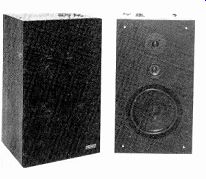
We who have admired the quality of and creativity inherent in so many Dynaco products over the years bid welcome to the "new" Dynaco. After the company's acquisition last year by the California-based ESS, we wondered what direction it would take. Its first offering is a trio of speakers; of these, we chose to test the A-250-the middle of the line.
Unlike its immediate predecessor, the A-25XL, this speaker is an acoustic-suspension design. The driver complement consists of a 10-inch woofer, 3-inch midrange, and I-inch soft-dome tweeter. Two continuously variable controls, located just above the spring-loaded connectors in a recess of the rear of the enclosure, provide midrange and high-frequency contouring. The midrange control is calibrated from-4 to +2 dB, values that are unusually close to the response variation measured at CBS Technology Center; the tweeter brilliance control is calibrated from-50 to +3 dB. Here the measurements on our test sample show the indicated boost but a less extreme-and, therefore, more useful-maximum cut.
With both controls at their flat (0-dB) settings, CBS found the A-250 capable of flat ...
--------
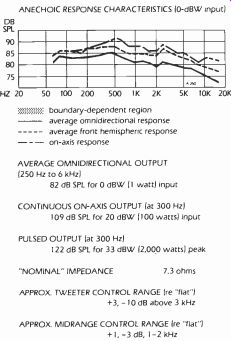
Dynaco A-250 loudspeaker
ANECHOIC RESPONSE CHARACTERISTICS 10-dBW input)
boundary-dependent region average omnidirectional response average front hemispheric response- on-axis response
---------------------
... and extended frequency response, the bottom end reaching down to around 40 Hz.
The data further disclose only moderate efficiency, as you would expect from an acoustic-suspension system. Power handling and dynamic range are excellent. The A-250 easily passed the continuous-tone test without exceeding distortion limits, and in pulsed-power tests, it handled almost 2 kilowatts before distortion became excessive. Only minor evidence of reflections or hangover in the pulses appears on the oscilloscope. Impedance values remain at or above the rated 8 ohms over most of the frequency spectrum, with the nominal 7.3 ohms occurring at 100 Hz.
At both moderately loud (89-dB) and loud (100-dB) sound pressure levels, third harmonic distortion remains quite low, averaging less than 1/2% over most of the audible band and just barely touching 1% at the highest frequencies at the loud level. At moderate levels, the "softer" second harmonics stay well below 1/2% across the midrange but rise to about 2% above 5 kHz; at the higher output, they average about twice these values.
In listening tests, we were unanimous in judging this a speaker that's easy to live with. Its tone is distinctly unboxy, with a minimum of midrange coloration. It projects an upfront stereo image that many find a dramatic plus. Bass response is quite good, and even deep organ fundamentals have fair definition. At higher frequencies, and even in very complex orchestral textures, definition is quite good, though our panel noted a certain harshness in occasional wind and bass passages.
Considered in toto, the A-250 is an admirable speaker of the sort traditionally associated with the Dynaco name. As that phrase implies, it cannot be called radical in any way, and it offers good value. Advance information hints that the new Dynaco electronics due to appear later this year will not be quite as tradition-minded, so perhaps this model should not be taken as a blueprint for things to come. It is, however, strong confirmation that Dynaco is not altogether abandoning its past under the new ownership.
================
A Successful First Deck Biases Itself
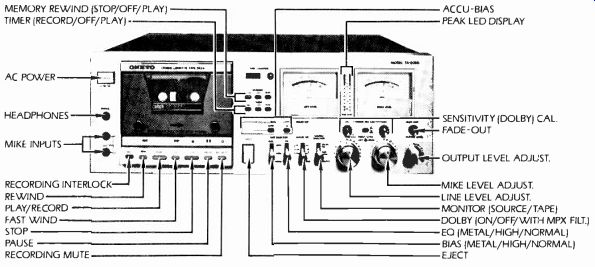
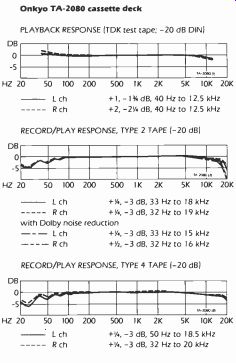
Onkyo TA-2080 cassette deck
Onkyo TA-2080 cassette deck, in metal case. Dimensions: 17 1/4 by 6 inches (front panel), 133/4 inches deep plus clearance for controls and connections. Price: $800. Warranty: "limited," two years parts and labor. Manufacturer: Onkyo Corp., Japan; U.S. distributor: Onkyo U.S.A. Corp., 42-07 20th Ave., Long Island City, N.Y. 11105.
A modern cassette deck is a complex device, particularly in terms of the interrelationship of its functional elements, and designing one that really works well presents a challenge that is not always met squarely even at companies with years of practice. When Onkyo announced its first line of decks last summer, we wondered how well a newcomer would do; on the basis of the TA-2080, and despite a couple of minor oddities, the answer is very well indeed.
In basic description it is a three-head deck (recording and playback heads are mounted in a single assembly fitting the main head opening in the cassette) with the virtually obligatory metal-tape capability, an automatic-biasing feature, and solenoid/logic controls for the two-motor transport with phase-locked servo capstan drive. Of these elements, the AccuBias feature is the most unusual. It is activated by a single button and records an alternating series of tones at 400 Hz and 10 kHz, adjusting bias until output level from the two matches precisely. When that is achieved (in only a few seconds), the MEMORY REWIND will return the tape to the starting point. The usual tape switching provides preprogrammed bias settings, but AccuBias is so quick and simple in use that it should be routine for all owners. If you move the main bias switch to a different position and forget to rerun the AccuBias for the new tape, the deck automatically reverts to the preprogrammed values to limit the "wrongness" of the setting. We appreciate this wrinkle after working with decks on which a single knob alters all tape-switch position biases, so that when you adjust one you necessarily misadjust all the others with respect to their standard settings.
There also is a sensitivity adjustment for Dolby tracking. The built-in oscillator, atypically, is wired ahead of the line-input level control, which therefore must be adjusted to bring the meters to their Dolby calibration mark in the SOURCE monitor position before the Dolby adjustment itself can be made. The fact that this system requires calibration may seem annoying; the fact that it permits calibration actually is a plus, since factory adjustment of the more standard post-control oscillators is not always precise. When you perform the operation, incidentally, you encounter one minor oddity of the design: The monitor switch is labeled SOURCE SELECTOR, which recordists used to the standard terminology may find momentarily confusing.
Of more moment is the evidence of indecision in the design of the metering system. Though a dual peak-LED display is provided, with one display for each channel, it is not calibrated finely enough for regular signal assessment. The meters are well calibrated-from +5 to-40 VU-but distinctly sluggish since they require pulse durations of V4 second or so to come within 3 dB of reading full value of the pulse. Consequently the careful recordist must use the two meters for a general idea of signal behavior and, simultaneously, keep a "third eye" on the upper portion of the peak display, watching for transients loud enough to threaten overload and brief enough to slip by the meters. We found no practical use for the lower range of the LED display, which we considered redundant with the meters.
We would have preferred a single, more capable display mode.
Onkyo's manual lists Maxell UDXL- II as the reference Type 2 tape (our basic reference in all cassette-deck tests), UDXL-I as the Type 1 ferric, and-with a little less emphasis-Scotch Metafine for Type 4. (In general, however, the list will only confuse most American owners since it is based strictly on the tapes and brand designations available in Japan.) Diversified Science Laboratories used these brands for the measurements and also checked out TDK D (a Type 0 ferric) in investigating the properties of AccuBias vs. the preset bias. The preset delivered almost identical results with Metafine, though AccuBias arguably improved performance by a tiny margin. With the other tapes AccuBias produced distinctly better results than the presets; in particular, that for ferric tapes is under-biased for UDXL-I and over-biased for D, delivering a peaky high end with the former and a severe rolloff with the latter. AccuBias gets excellent results from both tapes. Again, we would expect owners to make routine use of the AccuBias even if these tests had not proved the wisdom of doing so.
Results range from good to excellent for all the AccuBiased tapes.
Distortion is low, but not quite as low as our distortion graphs indicate because appreciable quantities of the second harmonic (in addition to the documented third) are present; generally, however, the THD runs no more than about 0.1% higher than the values in the chart. Response with all the tested tapes is quite flat, and noise figures are down where they should be in a quality deck. Taking these considerations together, you will note that the Type 1 tape gives the others fairly stiff competition, though it is the least expensive. Its midrange headroom is almost as high as the metal, its response almost as extended as the Type 2, its noise not much higher than either, and its distortion curves the lowest of the three. In use we sometimes judged it the cleanest sounding, though the Type 4 metal tape, predictably, did best where high-frequency headroom was required.
Onkyo thus has done more than just avoid pitfalls in its first cassette decks: It has achieved genuine quality in its first try, judging from this flagship model.
It contains a number of extras-a fadeout control for erasing the tail end of a recording that has been allowed to run a little too long (say, into the subsequent announcement on FM), both MEMORY STOP and MEMORY PLAY rewind options, a RECORDING MUTE, and so on-but none is particularly radical or arcane. Which is to say that, while the TA-2080 breaks no ground that is altogether new and caters to no special-interest group among recordists, it is a solid deck of well-accepted mold.
-----------------
A Quick Guide to Tape Types:
Our classifications, Types 0 through 4, are based largely on those embodied in the measurement standards now in the process of ratification by the Inter national Electrotechnical Commission.
The higher the type number, the higher the tape price generally is in any given brand. Similarly, the higher type numbers imply superior performance, though-depending in part on the deck in which the tape is used-they do not guarantee it.
Type 0 tapes represent "ground zero" in that they follow the original Philips-based DIN spec. They are ferric tapes, called LN (low-noise) by some manufacturers, requiring minimum (nominal 100%) bias and the original, "standard" 120-microsecond playback equalization. Though they include the "garden variety" formulations, the best are capable of excellent performance at moderate cost in decks that are well matched to them.
Type 1 (IEC Type I) tapes are ferrics requiring the same 120-microsecond playback EQ but somewhat higher bias.
They sometimes are styled LH (low-noise, high output) formulations or "premium ferrics." Type 2 (IEC Type II) tapes are in tended for use with 70-microsecond playback EQ and higher recording bias still (nominal 150%). The first formulations of this sort used chromium dioxide; today they also include chrome-compatible coatings such as the ferricobalts.
Type 3 (IEC Type III) tapes are dual-layered ferrichromes, implying the 70-microsecond ("chrome") playback EQ. Approaches to their biasing and recording EQ vary somewhat from one deck manufacturer to another.
Type 4 (IEC Type IV) are the metal-particle, or "alloy" tapes, requiring the highest bias of all and retaining-the 70-microsecond EQ of Type 2.
------------
Another Winner from Koss
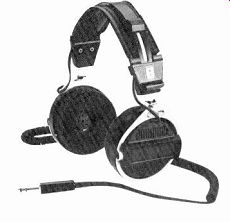
Koss HV/X stereo headset, with 10-foot coiled cord. Price: $70; also available as the HV/XLC with individual earpiece level controls, $80.
Warranty: "limited," one year parts and labor.Manufacturer: Koss Corp., 4129 N. Port Washington Ave., Milwaukee, Wis. 53212.
The Koss HV headphone series is designed around the premise that total isolation from your aural environment is undesirable in some kinds of listening.
We agree both with that premise and with its obverse: that isolation (such as that provided by Koss's own classic Pro series) is desirable in other types of listening.
Headphones got their start in audio as monitoring devices for recording locales without control rooms and therefore without the option of using loudspeakers to evaluate the sound pickup. High acoustic seal obviously is necessary for this purpose.
In home listening, isolation may be needed where ambient noise levels are high or may be preferred just as a means of escape from the here and now through music.
But we generally experience less listening fatigue with the so-called open-air designs like the HV, because they do not, in fact, subject the listener to a sense of total isolation. The choice thus is influenced by living conditions, life styles, musical tastes, and program material. And since virtually all commercially available program material is in stereo-that is, specifically intended for reproduction on a pair of speakers-purists will object that any use of headphones with programs not captured binaurally for this purpose is, at best, a compromise. Even so, there are circumstances (late-night listening, for example) under which it is a desirable compromise.
Like the HV-1 (test report, July 1974), the HV/X aims to satisfy the listener who objects to the weight as well as the acoustic isolation of sealed-cup phones yet misses the deep bass response lacking in some open-air designs. Koss's solution involves the use of variable-density foam ear cushions. Though the ear is surrounded completely by the circumaural cushion, the wearer notices immediately that normal ambient sounds are diminished only slightly. The cushion is made of a very porous foam that remains acoustically transparent at its low-density perimeter but is compressed, and therefore acoustically more opaque, toward the inner side.
This variable density provides a pattern of acoustic resistance that controls dissipation of the bass frequency range without inhibiting the passage of mid and high frequencies. Koss also claims that the bass boost afforded by these earcups permitted a major modification to the drivers, lightening them considerably. In fact, at a featherweight 7.8 ounces and with the squishy foam cushions gently resting on (and warming) one's ears, the HV/X is among the most comfortable, least fatiguing headphones we've ever used.
But how does it sound? In a word, exceptional. Auditioning it with bands of pink noise, we could find little if any rolloff of high frequencies up to about 15 kHz, and bass response remains firm into the nether regions around 50 Hz.
Reproduction in the lower registers has a sonorous richness usually associated with sealed-cup designs, and midrange presence is raised to an exciting, if slightly surreal, level. Also pleasing in this headset is the kindness with which it treats those ever present extramusical details: The breathiness of the singer and the slip of the fingers down the strings of the guitar are not exaggerated. We could find no evidence of distortion at any listening level short of our threshold of physical discomfort. (Koss rates the HV/X for 120 dB SPL, a fearsome figure.) With a rated impedance of 90 ohms at 1 kHz, the HV/X should suit the headphone jacks of receivers, amplifiers, and most preamps and tape recorders. (But, again, the low-seal design is not essentially appropriate for critical monitoring during live recording, and the headphone output from many tape decks is, in any event, inadequate for high-level listening with most headphones.) The coiled cord extends from its 3-foot length to a maximum of around 10 feet, and in overall construction the set seems fairly rugged for such a lightweight unit. As an all-purpose headphone to delight and tickle you in your private moments, the HV/X can be heartily recommended.
======================
A Graphic-Plus Equalizer
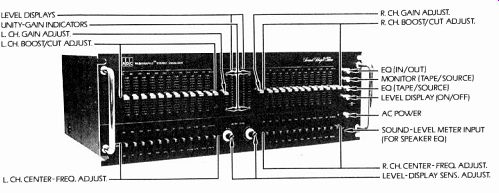
-------
LEVEL DISPLAYS UNITY-GAIN INDICATORS L 0-1. GAIN ADJUST.
L.CH. BOOST/CUT ADJUST.
L. CH. CENTER- FREO. ADJUST.
R CH. GAIN ADJUST.
R CH. BOOST/CUT ADJUST.
EO (IN/OUT) MONITOR (TAPE/SOURCE) E0 (TAPE/SOURCE) LEVEL DISPLAY ION/OFF) AC POWER SOUND-LEVEL METER INPUT (FOR SPEAKER EO) R. CH. CENTER- FRED. ADJUST.
LEVEL-DISPLAY SENS. ADJUST
---------------------
ADC Sound Shaper Three Para-graphic equalizer, in metal rack-mountable case. Dimensions: 19 by 6 1/4 inches (front panel), 12 inches deep plus clearance for handles, controls, and connections. AC convenience outlet: one unswitched (200 watts max.). Price: $500; optional SLM-3 sound-level meter and calibration record, $70.Warranty: "limited," two years parts and labor. Manufacturer: made in Taiwan for Audio Dynamics Corp. Professional Products Group, BSR (U.S.A.), Ltd., Route 303, Blauvelt, N.Y. 10913.
The ADC/BSR equalizer line has been growing more or less constantly ever since BSR acquired Metrotec some years back. In retrospect, that seems like a humble beginning; the little Metrotec graphic unit was a dandy accessory in its day, however, and it laid the foundation for the imposing Sound Shaper edifice. Until recently all models in the line were graphic equalizers, yet the numbers of control bands and the switching options have grown, producing ever more flexibility of use and sophistication of behavior. The Three, for example, has full pre/post-tape switching (a must, in our view, for recordists who want to equalize program material, though it took a long time for this feature to become commonplace), a level-matching display and trim controls (to prevent distortion from overdriving any portion of your system or noise from under-driving it, and to make EQ in/out A/B comparisons meaningful-and here employed as a reference for speaker equalization), and separate sliders for each stereo channel (sometimes desirable for program EO, even more important for speaker EQ). The most striking innovation is the bottom rank of switches, which shift the bandpass frequencies of the twenty four sliders-twelve for each channel, spaced a little less than an octave apart upward or downward by approximately a quarter-octave.
This is what ADC calls its Paragraphic design, a term that needs some explanation. In its main outlines, the Three is a graphic equalizer: Once set, frequency band by frequency band, the sliders give you a "graphic" display of the response curves they create. Parametric equalizers work not with manufacturer-mandated frequency bands, but with the individual parameters of response shaping: frequency (band centers), 0 (bandwidth and band sharpness), and-like the graphics-level (cut or boost within the chosen band). ADC's Paragraphic design includes no control of 0 as such; to create a band broader than those controlled by its individual sliders, you must "construct" it with the aid of neighbori9g sliders. The resulting envelope therefore may not be quite as smooth and regular as you would expect from a parametric model, but with modest degrees of boost or cut, the differences are vanishingly small, and even settings extreme enough to show band-to-band ripple on graphic-equalizer response curves may sound identical to their parametric equivalents. The Three does add the frequency-shift option not normally found on graphic designs-though in discrete positions, rather than the continuous variability of the parametrics. And, most important in practice, the basic layout and behavior of the Three is that of a graphic model. Thus we approach it as a graphic equalizer whose subtlety of control will deliver results comparable to those from a parametric. It is not, in our view, really the functional combination of parametric and graphic designs that the name might suggest.
Since the significance of the last statement goes to the way in which one thinks about and goes about using the device, it also goes to the dual applications to which the Three addresses itself. In the best of all possible worlds, where no regard for price is necessary, we would want to use one easily accessible equalizer to correct any response problems in the program signals and another preferably hidden away where its "ideal" settings won't be tampered with-to "fix" speaker response. ADC, like its competitors, realizes that this is a luxury few of us can afford; the Paragraphic design is intended to encompass both applications with as much grace and as little compromise as possible.
ADC also offers the SLM-3 sound-level meter and a calibration record to use in speaker setup, and we suggest that you do so. If you don't want to lay out $70 for an item that, at least in theory, you'll never need again as long as you don't change your speakers or your room, ask your ADC dealer about renting or borrowing one; he may be happy to accommodate you in view of the equalizer sale that will go with it. Without cataloging the always-onerous task, we found the process roughly comparable to that with most top-quality speaker equalizers-all of which make the simpler models look like the inadequate half measures they are.
Conventional theory dictates that response anomalies cannot be heard unless they extend over at least a third of an octave and that third-octave filter bands are therefore ideal for this purpose. The Three's bands are a little wider, but we're satisfied that the frequency-tuning switches do, indeed, give you all the control you need. The calibration and adjustment process depends on the front-panel LED display, which runs in 2-dB steps, yielding information with an effective accuracy of ± 1dB; if you want to chase after fractions of dB (and we see no real point in that), you'll have to use more sophisticated measuring equipment.
As a program equalizer, the Three works very well indeed. It will do most of the things a parametric equalizer will do (the main difference being the even narrower bands usually available on a parametric, though they seldom are needed in home use) and some that it won't; very complex response curves are simple on the ADC but might require more controls than most parametrics offer. This application is, of course, where the bank of switches at the right end of the front panel plus the level-matching controls at the center are invaluable.
The lab data turn up no disappointments. Bandpass (or band suppress) characteristics are quite consistent from slider to slider; the calibrations for frequency and for dB of boost or cut are reasonably accurate-more so, in fact, than usual.
Distortion (which always is higher in an equalizer than in, say, a preamp) is well controlled. And, despite the wide latitude afforded by the level-matching controls, so is noise.
For those who want an exceptionally flexible graphic equalizer, the Sound Shaper Three strikes us as excellent in both conception and execution. (If you want something simpler, ADC has models to oblige, of course.) For program equalization, it may not offer quite the frontal attack of parametrics on some sorts of problems, but it's no less capable when it comes to solutions. And it can be used for speaker equalization, where true parametrics are useless for all but the most rudimentary touchups.
----------------
ADC Sound Shaper Three equalizer
OUTPUT AT CLIPPING 9 volts HARMONIC DISTORTION ITHD; 20 Hz to 20 kHz)
0.5 Vin, 2.0 V out IIHF) 1 V in, 1 V out (normal use) 0.028%
FREQUENCY RESPONSE
+0,-V. dB, 10 Hz to 260 kHz;
+0,-3 dB, < 10 Hz to 460 kHz sliders centered sliders at max.
(sliders centered unless otherwise specified) INPUT CHARACTERISTICS IIHF loading, A-weighting) sensitivity S/N ratio 79 mV 101 dB 90 dB 50.15%

-------------
Report Policy: Equipment reports are based on laboratory measurements and controlled listening tests. Unless otherwise noted, test data and measurements are obtained by CBS Technology Center, a division of Columbia Broadcasting System, Inc., and Diversified Science Laboratories. The choice of equipment to be tested rests with the editors of HIGH FIDELITY. Samples normally are supplied on loan from the manufacturer. Manufacturers are not permit ted to read reports in advance of publication, and no re port, or portion thereof, may be reproduced for any purpose or in any form without written permission of the publisher. All reports should be construed as applying to the specific samples tested; HIGH FIDELITY, CBS Technology Center, and Diversified Science Laboratories assume no responsibility for product performance or quality.
---------------------
(High Fidelity, Apr 1980)
Also see:
Audio Research SP-6 preamplifier